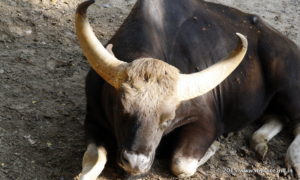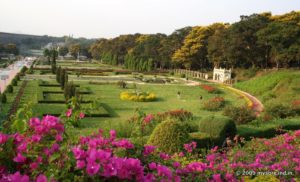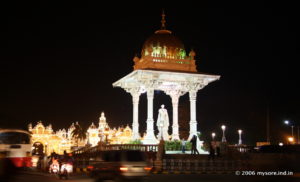
 Scan to see this page on your mobile phone
Scan to see this page on your mobile phoneThe original church stood here was built more than 150 years back. What you visit now as the St. Philomena church was built in 1933. This is an important and one of the largest churches in south India.
After the fall of Tippu Sultan in 1799, Mysore had a significant European population. The original church was built mainly cater to the need of this expatriate population living in Mysore. The land for constructing the church was given by the then maharaja, Krishnaraja Wodeyar III in 1843.
An inscription of the time reads, "In the name of that only God - the universal Lord who creates, protects, and reigns over the universe of Light, the mundane world and the assemblage of all created lives - this church is built 1843 years after the incarnation of Jesus Christ, the Enlightenment of the World, as man"
Saint Philomena ( venerated as a virgin martyr saint of the Catholic Church in the 19th century ) is said to have been a young Greek princess martyred in the 4th century.
In 1926, TRV Thamboo Chetty, the Diwan and Chief Justice of the then Mysore kingdom under Krishnaraja Wodeyar IV, brought a relic (image) of saint Philomena from Peter Pisani, Apostolic Delegate of the East Indies. You can see this image in the catacomb located beneath the altar.
On October 28, 1933 the Maharaja of Mysore Krishnaraja Wodeyar IV laid the foundation stone of the new church, at the same site given by his grandfather about 90 years back. The Maharara is quoted to have said, " The new church will be strongly and securely built upon a double foundation — Divine compassion and the eager gratitude of men " The commemorative plaque is located on the outer wall of the church, adjacent to the main doorway to the hall. The paintings in Mysore Palace has an interesting one depicting the St. Philomena's church.
The inspiration for the church's design was the similar looking, and much bigger Cologne Cathedral of Germany. The architectural style is popularly called neo-Gothic or Victorian Gothic style, that was popular in Europe during the time. Typically this style spot slimmer and unusually taller features with needle like spires. The design was done by a Frenchman called Daly under the supervision of Bishop of Mysore Rev. Rene Fuga. The construction was completed in 1941, eight years after the foundation stone was laid.
What is peculiar about the design of St. Philomena's church is its length and height of the church are identical ( 175 feet ). And more interestingly the plan of the church looks like a cross.
The long part of the cross is the 'nave', which is the congregation hall. The 'transepts' are the arms of the cruciform.The upper portion houses the altar and the choir is in the intersection.
The beautifully carved marble altar contains the statue of Saint Philomena, which was brought from France. You can see many stained glass images depicting biblical events like birth of Jesus Christ, the Last Supper, the Crucifixion and the Resurrection.
At the end of the congregation hall near the choir is the steps to the underground catacomb. This can also be accessed through the narrow underground corridor from outside the church.
The spires spot two 12 feet crosses as the final. These two spires protrudes out of the skyline of this undulating landscape. You can see these spires from miles away, especially in the night when that neon lining around the crosses are switched on.
That popular quote about this church explains it all : " A priceless French statue of a celebrated Greek saint in a German cathedral located in the heart of India."
St. Philomena's church is located on the ever busy Ashoka Road that radiates out of the city from the north of Mysore Palace. Form the north gate of the palace (Chamaraja Circle), the church is about 1½ km (about 1 mile) on the Ashoka Road. Opposite to the church on the same road is Masjid-e-Azam, a famous mosque in Mysore.
Photography is not permitted inside the church hall.












